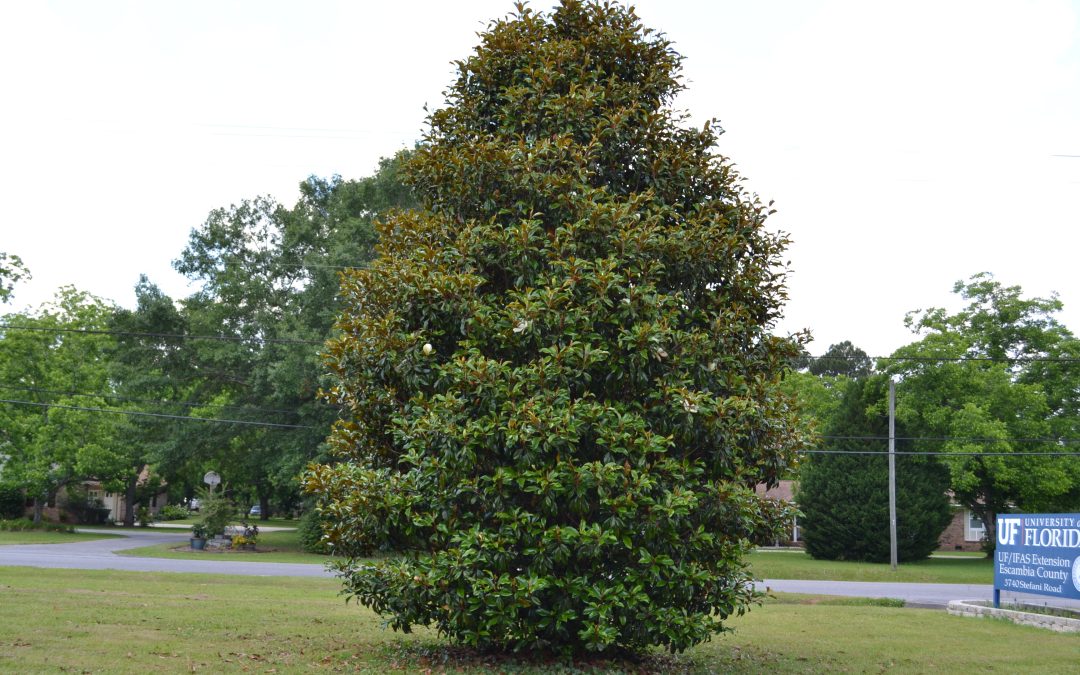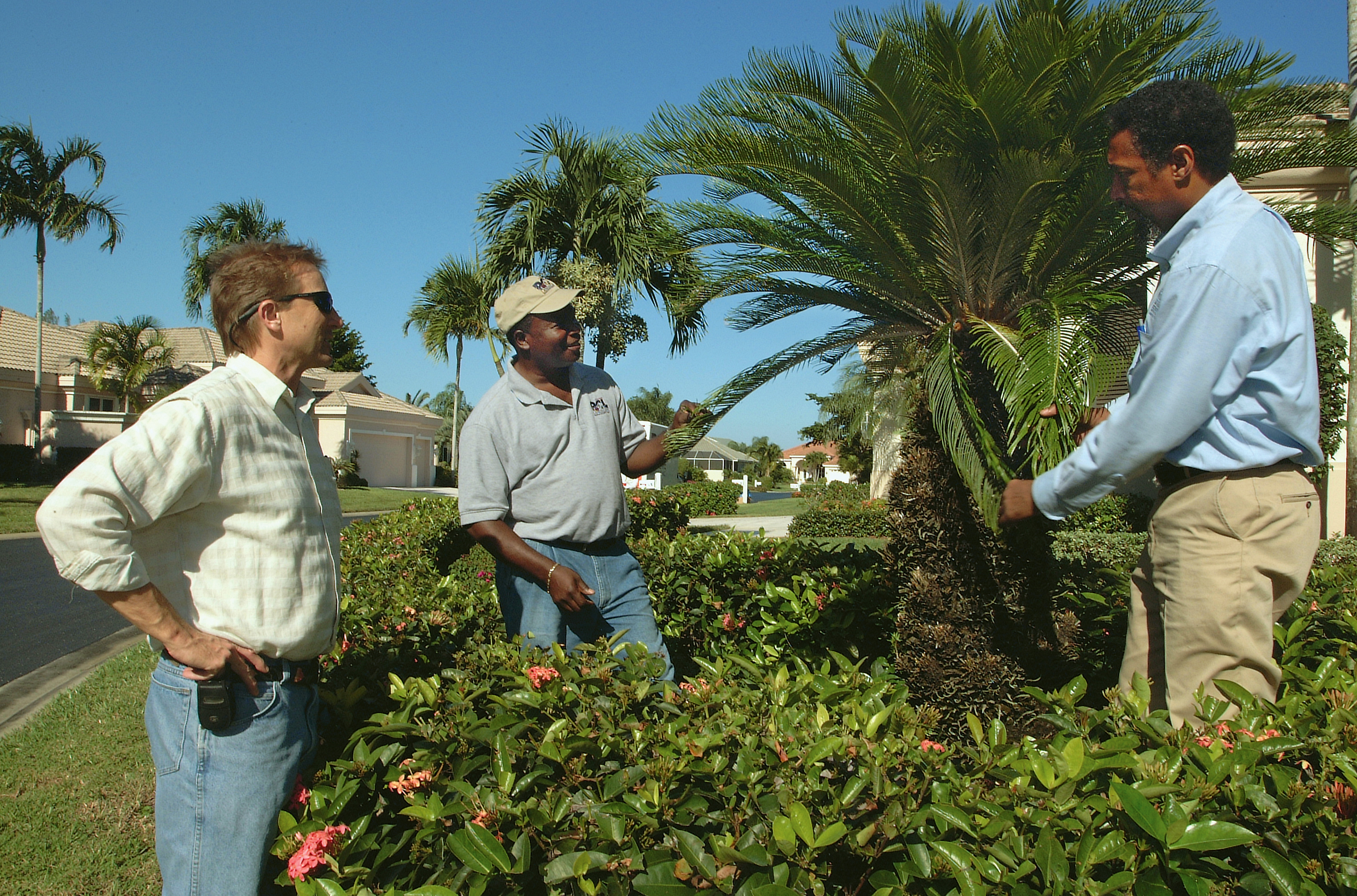
by Matt Lollar | May 28, 2025
Gardening just wouldn’t be any fun without the pests. In this episode of Gardening in the Panhandle LIVE!, the hosts answered some very important questions about different types of pests in Florida lawns and landscapes. Before we talk about some of the specific topics from this episode, it’s critical to know the definition of a pest when it pertains to our yards. A pest is any organism that is harmful and/or damaging to humans or the property of humans such as crops and livestock. Weeds are pests, some insects are pests, and diseases are pests.
Integrated Pest Management or IPM for short is the use of different pest management strategies to help control pests. The UF/IFAS Publication Landscape Integrated Pest Management provides more details on the steps involved in a good IPM program.
As stated above, pests can come in a lot of forms. Pesticides offer control for some pests. The article The Basics of Pesticides provides more information on using pesticides.
“Natural” can be a vague term. You’ll want to read the UF/IFAS publication Natural Products for Managing Landscape and Garden Pests in Florida to help clarify the definition of natural pesticides and offer some natural control options.
If you’re growing edible crops, then you’ll need to follow some extra precautions to make sure your crops are safe to eat. A Florida-Friendly Landscaping Approach to Pest Management in Your Edible Landscape provides IPM strategies specific to fruits, vegetables, and herbs utilized in the landscape.
Some annual weeds are easier to control as the germinate. Pre-emergent herbicides provide a barrier that kills most annual weeds shortly after they germinate. Apply pre-emergent herbicides in late winter before day temperatures reach 65°F–70°F for 4 or 5 consecutive days and in the fall when nighttime temperatures drop to 55°F–60°F for several consecutive days.
The first step of IPM is to scout for pests. More information on scouting can be found in the article Scouting: The tip of the IPM spear from Matt Smith with the UF/IFAS Extension in Lake County.
The larva of many beetle species like to eat turfgrass roots. More information on June beetles and their control can be found in the fact sheet June Beetles (White Grubs).
Ground pearls are very difficult to control. The UF/IFAS publication Ground Pearls, Margarodes spp. (Insecta: Hemiptera: Margarodidae offers detailed information of these underground relatives of armored scales.
Snakes usually help us control pests around our homes. If you’re interested in what snake species live in Florida, then you’ll want to read the UF/IFAS publication Managing Conflicts with Wildlife: Living with Snakes.
Chinch bugs are a major insect pest of Saint Augustinegrass. The UF/IFAS publication Southern Chinch Bug, Blissus insularis Barber (Insecta: Hemiptera: Blissidae) provides some valuable information on this insect pest and how to control it.
Fire ants are a direct pest of humans and the create some unsightly mounds in the yard. A number of baits are available on the market to help keep them out of the landscape. The article Sustainable Fire Ant Control offers more details on baits and other fire ant control strategies.
Mole crickets are another type of insect that feed on turfgrass roots. The Mole Cricket IPM Guide for Florida is a great place to start if you’re trying to understand this pest better.
If you’re sticking with an edible landscape theme, then you’ve certainly encountered leaf-footed bugs and stinkbugs on your fruit and vegetable crops. Larry Williams with the UF/IFAS Extension in Okaloosa County has written a very informative article on leaf-footed bugs titled Leaf-footed Bugs Are Common On Tomatoes.
The extension publication Weed Management Guide for Florida Lawns offers a variety of weed management strategies for your yard.
Weed control in plant beds can sometimes be tricky. The UF/IFAS publication Improving Weed Control in Landscape Planting Beds provides solutions for managing weeds around shrubs and ornamentals.
Products containing glyphosate are good for spot spray applications in the landscape, however some people may choose to avoid its use. The UF/IFAS publication Use of Glyphosate and Herbicide Alternatives for Weed Control in Florida Landscape Planting Beds discusses the advantages and disadvantages of using glyphosate and other herbicides.
Pests can wreak havoc on healthy lawns and landscapes. The resources and advice provided in this episode of Gardening in the Panhandle LIVE! will help you maintain a beautiful setting to enjoy. To view this episode of Gardening in the Panhandle LIVE! please visit our YouTube channel.
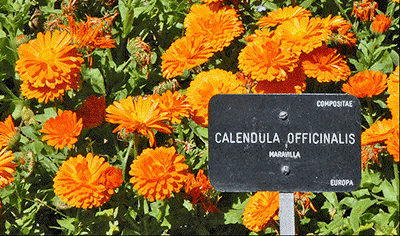
by Donna Arnold | May 22, 2025
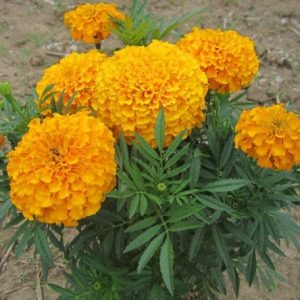
Spring and summer bring an explosion of color to gardens, and among the most resilient yet misunderstood flowers are marigolds. Growing up in a small Caribbean town, marigolds were everywhere. Locals called them “Stink and Pretty” or even “graveyard flowers” for their bold scent, but their benefits were undeniable. Whether used in traditional medicine, religious rituals, or tucked into garden beds to keep pests at bay, marigolds have always been more than just a flower.
More Than Just a Bloom
Belonging to the Tagetes genus, marigolds come in a variety of cultivars, each offering unique traits and advantages. Beyond their beauty, they play essential roles in soil conditioning, pest control, especially against nematodes, and companion planting.
A Closer Look at Marigold Varieties
Marigolds fall into distinct categories, each with different growth habits, flower forms, and benefits. The two most common types are Tagetes patula and Tagetes erecta.
- French Marigold (Tagetes patula)
Compact and bursting with warm hues of orange, yellow, and mahogany, French marigolds are excellent pest deterrents. Often planted alongside vegetables, they help manage soil nematodes while thriving in borders and containers.
- African or Perfection Yellow Marigold (Tagetes erecta)
Despite the name “African,” this species hails from Central America. Taller and more dramatic than French marigolds, it produces large, showy golden blooms ideal for cut flowers and mass plantings.
- Signet Marigold (Tagetes tenuifolia)
Delicate foliage, small dainty flowers, and an edible twist—Signet marigolds are a favorite for adding color to salads and attracting pollinators. Plus, their milder scent makes them perfect for gardeners sensitive to stronger fragrances.
A Common Mix-Up
It’s worth noting that while often called “Pot Marigold,” Calendula officinalis is not part of the Tagetes genus. Though it shares similar colors and benefits, calendula is better known for its medicinal properties and edible petals.
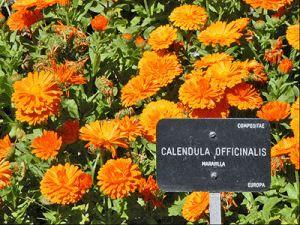
Calendula in the Royal Botanical Garden of Madrid, Spain. Photo by Jean-Pierre Dalbéra.
Next time you pass a tray of marigolds at a plant sale or see them brightening a garden bed, take a second look. These unassuming blooms do far more than add beauty—they may just be the unsung heroes of your summer garden.
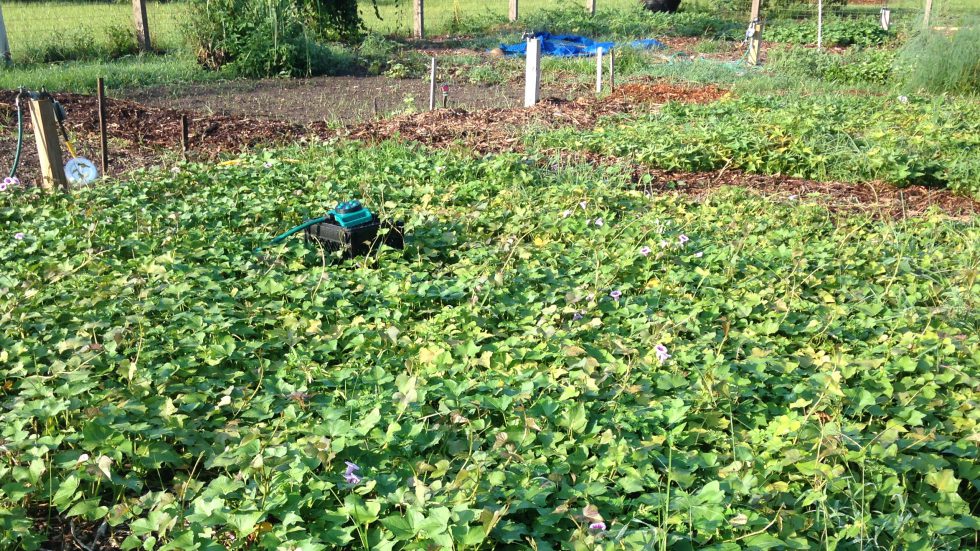
by Joshua Criss | May 22, 2025
Sweet potatoes (Ipomea batata) are a much ballyhooed southern food staple. Valued primarily for their tuberous roots, they also boast an edible leaf. That, however, is not the end of their story. Some cultivars find use strictly as an ornamental. While not the subject of this article, you will typically find these dangling over rock walls or cascading from a hanging basket. While these can be quite impressive, this article will focus on the edible version of this plant, and its nutritional benefits.
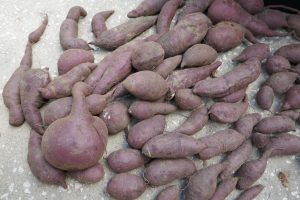
UF/IFAS photo: M. Bailey
What Cultivar?
As with any vegetable, these have been heavily bred to optimize growth and yield in our southern environment. In Florida’s Panhandle, ‘Centennial’ and ‘Beauregard’ are two varieties that perform admirably. They have a vining growth habit and are very productive. For those gardeners with less space, ‘Vardaman’ sweet potatoes. This cultivar has a bushy growth habit rather than a trailing vine.
Planting
Sweet potatoes are not planted by seed, but rather from a “slip”. These are the vegetative growth from the mature sweet potatoes. While it is possible to grow these yourself, it is better to utilize certified disease-free slips from a reputable garden supply store. Use slips that are 6 to 9 inches long, planting them in rows 48 to 54 inches on center, with plants spaced 12 inches apart.
Sweet potatoes can be planted in early spring through late June. These plants thrive in sandy soils, which are typical in the Panhandle with very little fertilization (approximately 0.04 lbs. of N on a 10 x 3-foot row). The downside to sweet potatoes is their exceptionally long growth season of 100 to 150 days after planting.
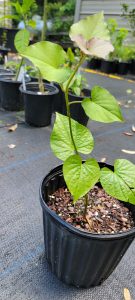
UF/IFAS photo: J. Criss
Pests
There are some pests which you’ll need to be wary when growing sweet potato. Most notably of these is the sweet potato weevil (Cylas formicarius). Even small amounts of damage from this insect can induce sweet potatoes with a foul taste. Control them through cultural practices such as turning your soil several months prior to planting, and adequate irrigation. Wireworms and beetle larvae are also concerns with sweet potatoes. Sample for grubs throughout the growing season, remove vegetation post harvest, and rotating your crops will keep these pests at bay. If all else fails, there are insecticidal options available. Consult your local extension agent to choose the appropriate option.
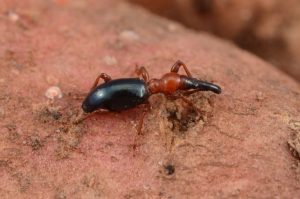
Sweet potato weevil UF/IFAS Photo: L. Buss
Time to Cure
Post harvest, sweet potatoes should be placed in a dark 85° room with 90% humidity for about two weeks. This is known as curing and will convert some of the starches of this vegetable to sugar making it slightly sweeter. Once the curing process is finished, store them in a cool, dry pantry at temperatures below 50°. This will keep them a viable staple in your pantry for several months.
The end result of all this work will be a food high in vitamin A, vitamin C and fiber that can be used for anything from home fries to pies.
To Sum Up
Growing your own vegetables in your own garden is a very rewarding experience. Sweet potatoes are an easy way to produce a lot of food for your family. If you’d like to know more about growing sweet potato, please consult these document. For more information on this topic or any other horticultural concern please contact your local U/IFAS extension office here.
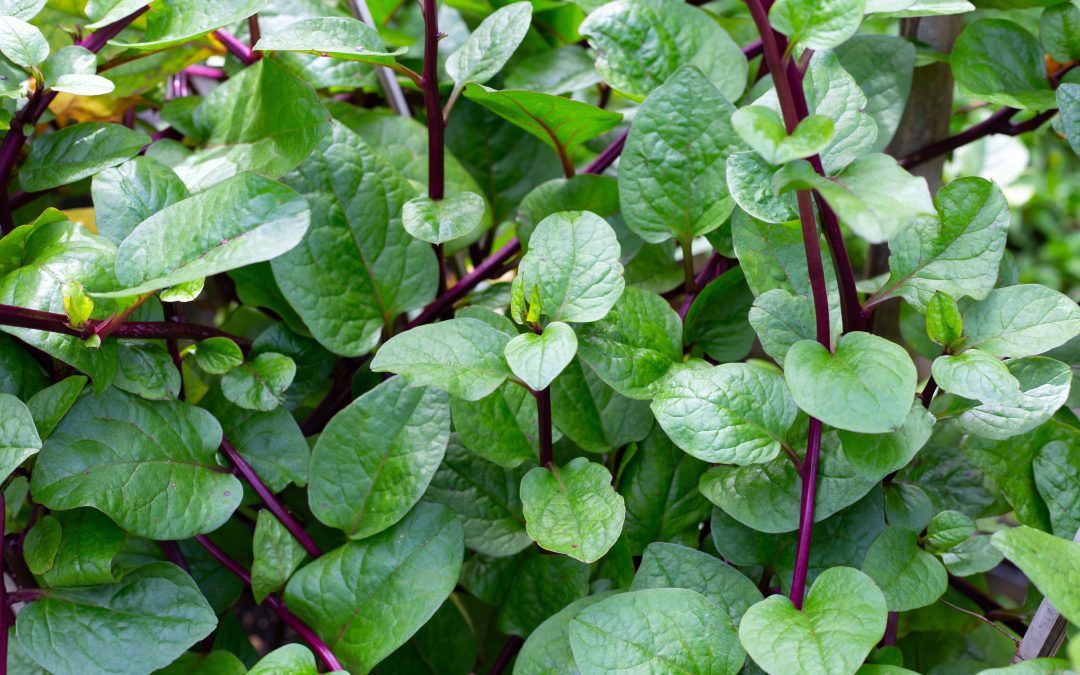
by Molly Jameson | May 15, 2025
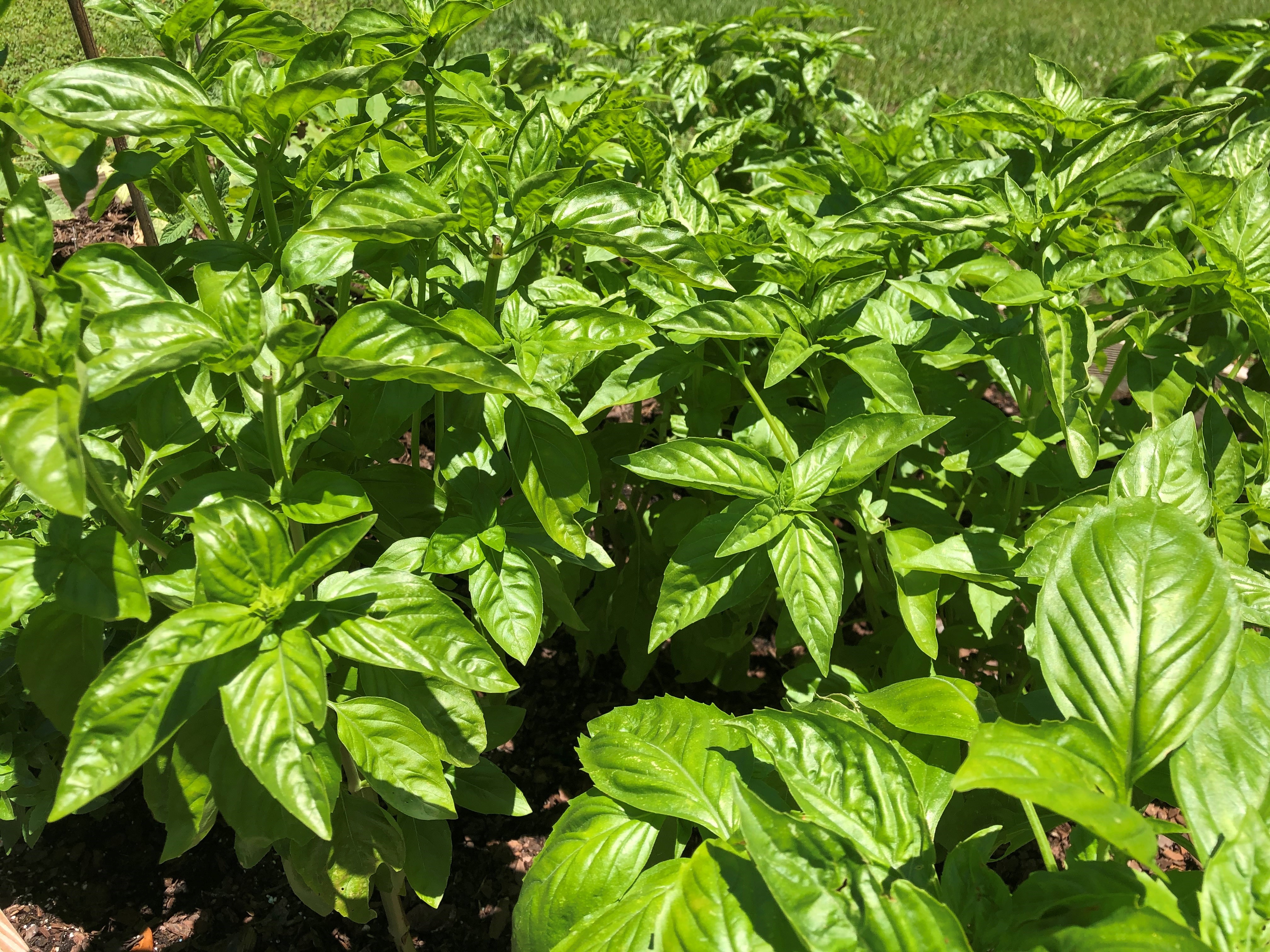
Sweet summer basil thrives in the heat – regular harvesting encourages bushier growth and delays flowering. Photo by Molly Jameson.
As the weather heats up, many spring vegetables begin to bolt, wilt, or shut down entirely. But for gardeners willing to shift gears, summer presents an opportunity to grow a new cast of crops that thrive in high temperatures, intense sun, and even occasional drought. Whether you’re growing in raised beds, in-ground rows, or large containers, these heat-loving vegetables are well-suited to our long summer season in the Panhandle.
Here are some of the best summer veggies to keep your garden productive when the thermometer climbs:
Okra
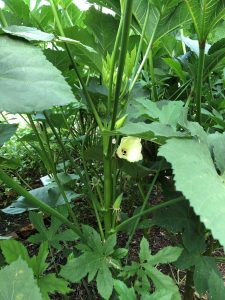
Okra thrives in the summer heat, producing edible pods just days after flowering. Photo by Molly Jameson.
Okra is a true warm-season crop that thrives in the heat and even tolerates periods of drought. For better germination, soak seeds in water for several hours or overnight before planting. Sow seeds directly into the garden once soil temperatures are at least 65°F and the danger of frost has passed – typically from late March through July. Plant seeds 1 inch deep and 4 to 6 inches apart in rows spaced 3 feet apart. Once seedlings are several inches tall, thin them so the remaining plants are spaced 1.5 to 2 feet apart. Pick pods when they’re two to four inches long, usually within a few days of flowering, to avoid tough, fibrous texture. Regular harvesting encourages more production throughout the summer.
Okra varieties well suited for our area include ‘Clemson Spineless’ and ‘Emerald,’ both known for their productivity and tender pods.
Southern Peas
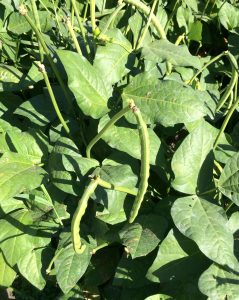
‘Zipper Cream’ southern peas are heat-tolerant and productive, with easy-to-shell pods and creamy, mild flavor. Photo by Molly Jameson.
Also known as cowpeas or field peas, southern peas are a staple crop across the South for good reason – they tolerate heat, sandy soil, and inconsistent rain. Sow seeds directly in June through August, spacing them about 2 to 4 inches apart in rows 18 to 30 inches apart, depending on the variety. Southern peas are nitrogen fixers, so they can improve soil fertility over time.
Popular southern pea varieties include ‘Pinkeye Purple Hull,’ ‘California Black-eyed,’ ‘Creel Crowder,’ and ‘Zipper Cream.’ These plants are also relatively pest- and disease-resistant, making them a great low-maintenance option.
Sweet Potatoes
Sweet potatoes are grown from slips – vine cuttings taken from sprouted tubers. These slips should be planted after the danger of frost has passed and soil temperatures are consistently above 65°F, typically April through June. Space slips about 12 to 18 inches apart in loose, well-drained soil. While mounding isn’t always necessary, creating raised ridges or planting in raised beds can help promote tuber development and improve drainage, especially in heavier or poorly drained soils. Sweet potatoes require a long growing season – around 90 to 120 days – but they produce abundantly and require minimal care once established. Their vines also form a dense ground cover that suppresses weeds and reduces soil erosion.
Two reliable sweet potato varieties for Florida gardens are ‘Centennial’ and ‘Beauregard,’ both known for their sweet flavor, high yields, and adaptability to southern growing conditions.
Malabar Spinach
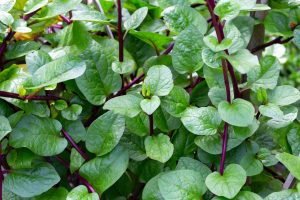
Red-stemmed Malabar spinach thrives in summer heat, producing tender, edible leaves on vigorous climbing vines. Photo by Bowonpat, Adobe Stock.
Malabar spinach is not a true spinach, but it provides tender, edible leaves throughout the hot months when traditional greens fail. It grows as a climbing vine, so give it a trellis or support to climb. Sow seeds directly into the garden or transplant young seedlings from mid-April through early June. This plant enjoys both sun and partial shade, and its thick, glossy leaves can be harvested regularly for salads or to thicken soups and stews. Just like regular spinach, frequent picking promotes new growth.
Both red-stemmed and green-stemmed Malabar spinach types are available, with the red-stemmed variety more commonly grown for its ornamental appeal.
Basil
Basil is a heat-tolerant herb that loves full sun and thrives in the warmth of summer. It can be direct-seeded or transplanted once the weather settles into consistent warmth, typically March through May in North Florida. Space plants about 10 to 12 inches apart and harvest often to prevent flowering and promote bushier growth.
In addition to classic sweet basil, try Thai basil or lemon basil for unique flavors that hold up in hot dishes and drinks alike.
Peppers
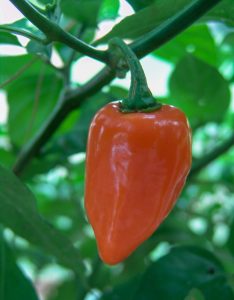
Habanero plants yield intensely hot peppers with a distinct tropical flavor. Photo by Gerald Holmes, Strawberry Center, Cal Poly San Luis Obispo, Bugwood.org.
Peppers – especially hot varieties – are well-adapted to Florida summers, although they benefit from a bit of afternoon shade during the most intense heat. Start with healthy transplants in spring or early summer, spacing them 18 to 24 inches apart. Keep the soil consistently moist and apply mulch to help retain moisture.
For sweet pepper options, try ‘Corno di Toro’ or ‘Sweet Banana.’ For heat lovers, datils, jalapeños, and habaneros all perform well in warm conditions. Just note that some varieties may slow production during extreme heat, then pick up again as temperatures moderate.
Take a Break with a Cover Crop
If summer gardening starts to feel overwhelming, you don’t have to plant every square foot. Consider giving part of your garden a seasonal rest with a warm-season cover crop like cowpeas, velvet beans, buckwheat, or even sweet potatoes. These vigorous growers help suppress weeds, improve soil structure, and add organic matter – and in the case of legumes like cowpeas and velvet beans, they also fix nitrogen to benefit future crops. Sweet potatoes, while edible, can also serve double duty as a weed-smothering ground cover.

Sweet potato vines form a dense summer ground cover that suppresses weeds and protects the soil. Photo by Janis Piotrowski.
For a lower-maintenance splash of color, consider heat-loving flowers like sunflowers, French marigolds, or zinnias – all of which attract pollinators and beneficial insects while brightening up your garden space.
Don’t let the summer heat bring your garden to a standstill! By choosing vegetables that are naturally adapted to our hot, humid conditions, you can keep your garden thriving and productive all season long.





